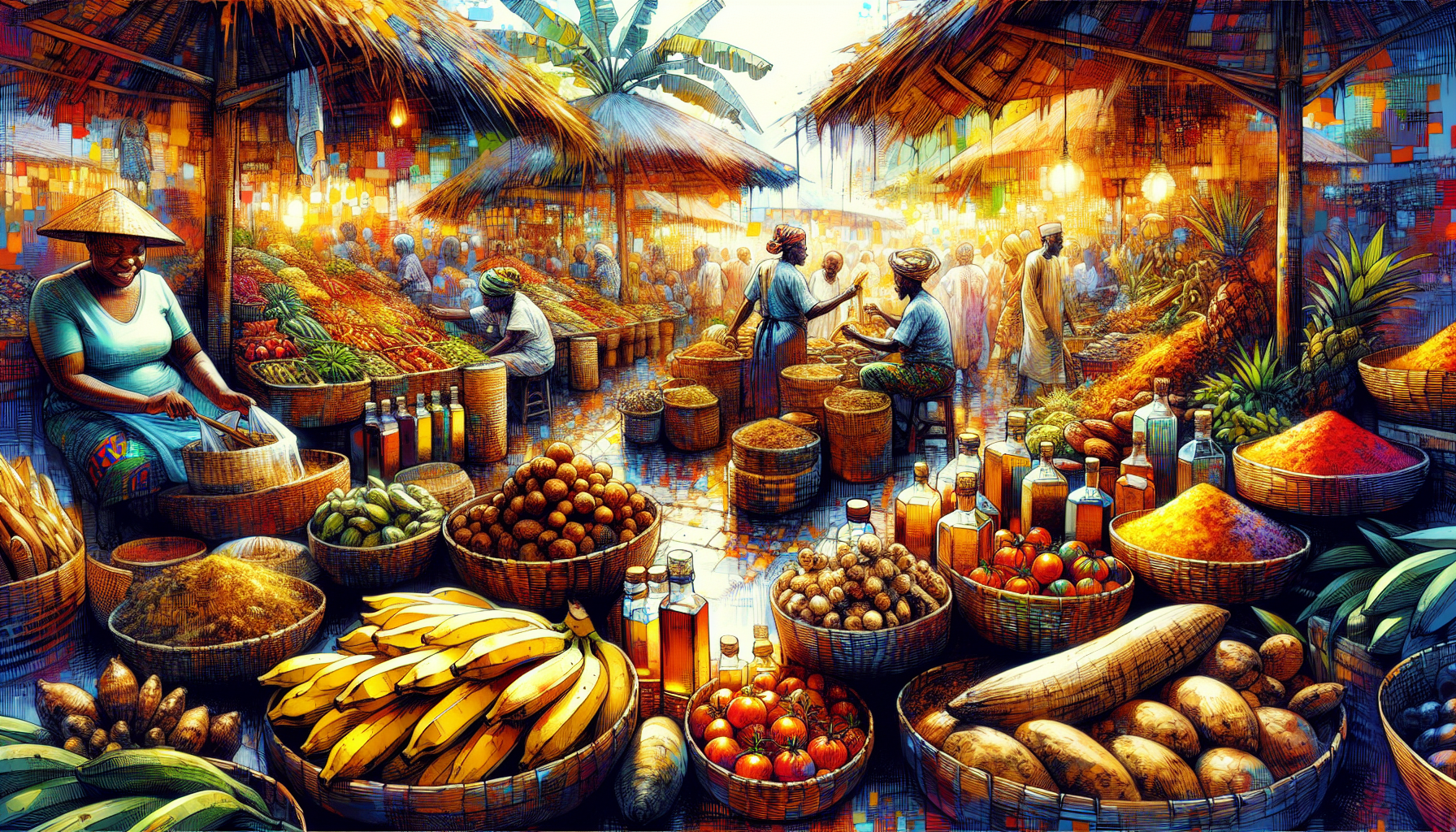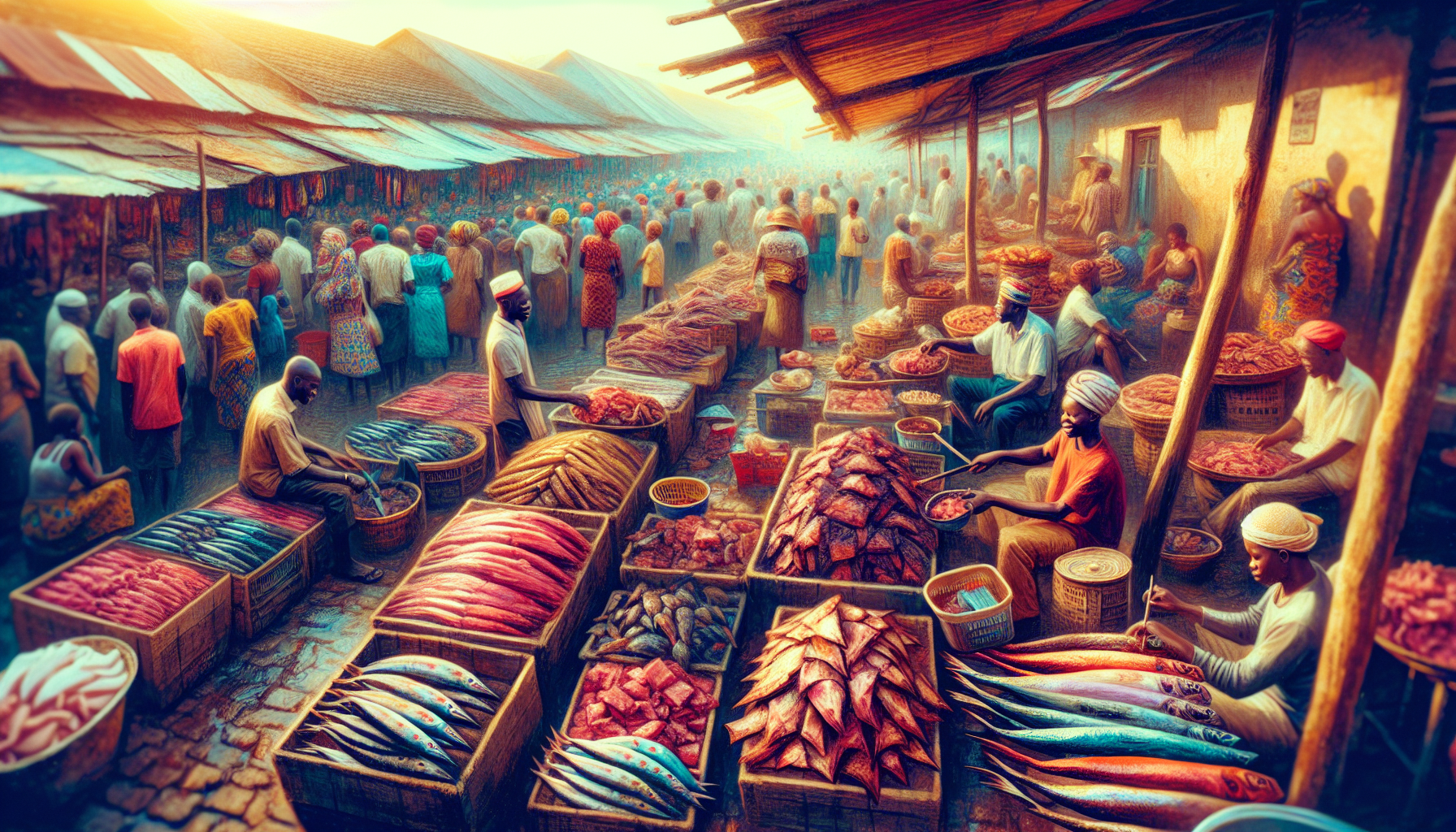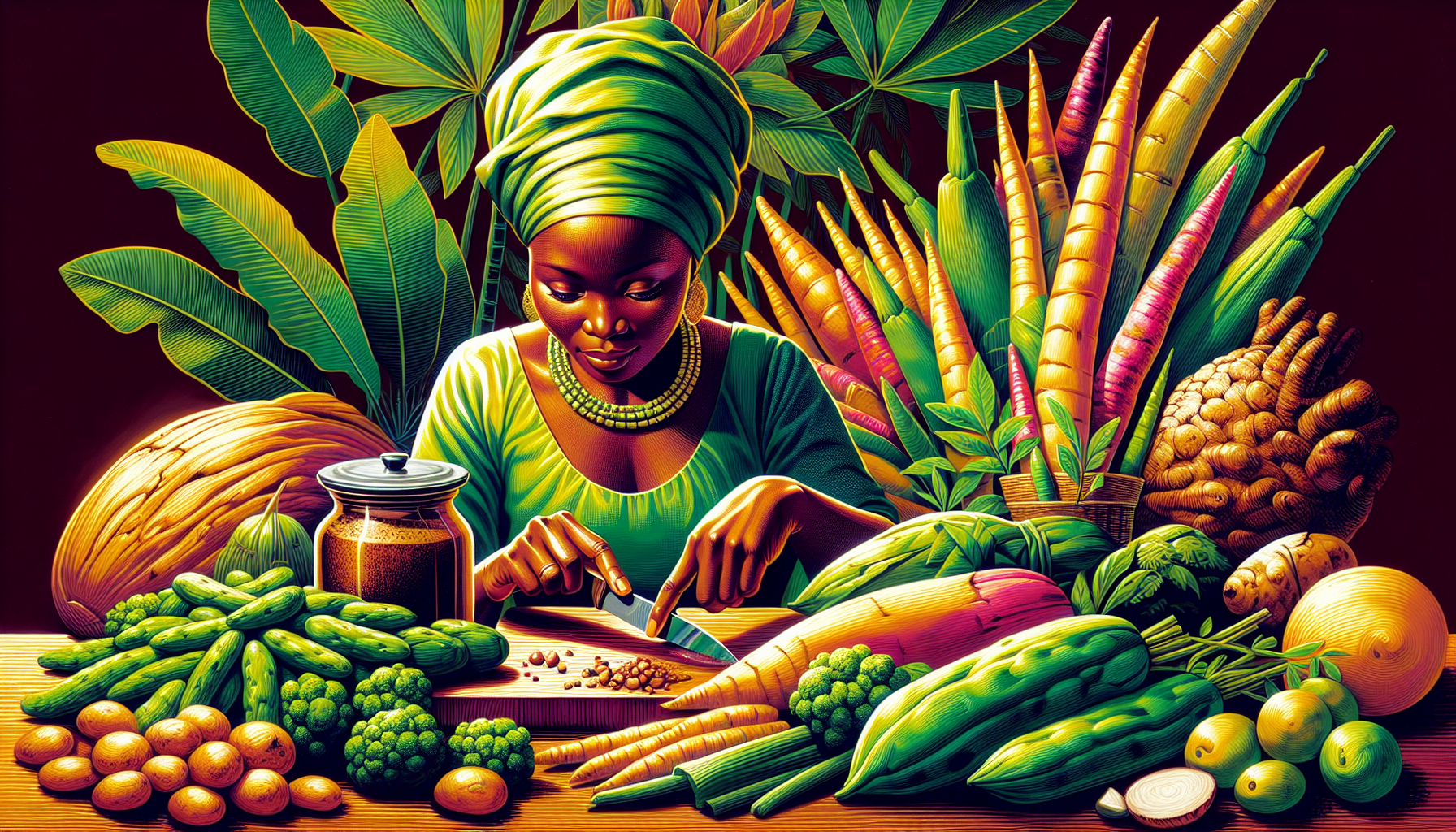Congolese food
Savor the richness and explore traditional Congolese food favorites.
What makes Congolese food a culinary treasure? Dive into the flavorful world of the Congo, where each dish is a blend of tradition and taste. Learn about the staple dishes, such as savory stews and fresh river fish, which are central to this rich culinary culture. Prepare to be transported through the diverse landscape of Congolese cuisine as we uncover its most cherished flavors.
Food from the Congo river
- Congolese cuisine is characterized by its regional diversity, cultural significance during events, and wide variety of dishes utilizing staple ingredients such as maize, cassava, plantains, and oils derived from palm and peanuts.
- Traditional cooking techniques include stewing, steaming, and preservation methods like drying and smoking which contribute to the complex flavors of dishes such as Moambe sauce, Chikwanga bread, and smoked fish preparations.
- Key components of Congolese meals include a rich selection of starches such as fufu and Chikwanga, an abundance of fish from the Congo River, hearty meat dishes including goat and insect cuisine, and spices like Pili Pili to enhance flavors, all often accompanied by traditional beverages like palm wine.
A Journey through Congolese cuisine

Congolese cuisine, with its tantalizing regional dishes and spicy stews, is a tapestry of flavors that mirrors the diverse culture of the Democratic Republic of Congo. From the banks of the Congo River to the tropical savannah regions of Central Africa, the country’s culinary landscape is as varied as its topography. Meals play a central role in religious events and celebrations, serving as the heart of social interactions and cultural practices. National Day on June 30th and other cultural events are marked with the preparation of special meals, showcasing the country’s culinary festivity.
The vast Democratic Republic of Congo boasts a fascinating culinary variety. The diversity, not merely geographical, reflects the rich cultural and ethnic tapestry of the nation. From popular plantain dish to chicken stew, the range of offerings is astounding.
The sweet potato (mbala ya sukali) and the unsweetened potato (mbala ya mungwa), two notable varieties of sweet potatoes, significantly represent the versatility and richness of Congolese culinary tradition.
Staple ingredients
Acknowledge the staple ingredients of Congolese cuisine is crucial for a comprehensive exploration. Common ingredients such as:
- maize
- rice
- cassava
- sweet potatoes
- yams
- taro
- plantains
- tomatoes
- pumpkin
form the backbone of most dishes. Plantains, for instance, are a key ingredient, found in many Congolese dishes and cooked in a variety of ways such as fried in oil, boiled, or even grilled. They are also served as popular snacks, showcasing their culinary versatility.
The use of oil and nuts in Congolese cuisine deserves special mention. Palm oil, derived from palm nuts, is a key ingredient used in traditional Moambe sauce, while peanuts, including roasted peanuts, are integrated into various dishes, particularly in peanut sauce that can accompany grilled meats or boiled starches like plantains and yam. These ingredients not only add flavor and texture to the dishes, but also enrich them nutritionally, making Congolese cuisine both delicious and nourishing.
Cooking techniques
Congolese cuisine employs a diverse array of cooking techniques, mirroring the variety of its ingredients. Stews, combining starches, vegetables, and meat, are a quintessential cooking method for preparing traditional main courses. These stews, made with a variety of ingredients, are slow-cooked to perfection, allowing the flavors to meld together and infuse the dish with a unique depth and complexity.
Steaming is another fundamental technique in Congolese cuisine, particularly in making Chikwanga, a type of Congolese bread. To prepare Chikwanga, cassava flour is wrapped in banana leaves and steamed, resulting in a unique and flavorful bread.
On the other hand, preservation techniques like drying or smoking are pivotal in African cooking traditions and are often integrated as seasonings in Congolese dishes. While snacks are commonly deep-fried, the main dishes are typically stewed, showcasing the diverse cooking methods used in the region.
Flavorful fish delights

Blessed with the Congo River, its tributaries, and various lakes like Lake Tanganyika, the Democratic Republic of Congo enjoys an abundance of fish, a key component of the local cuisine. The variety of fish dishes in Congolese cuisine is a testament to the resourcefulness and creativity of its people. Some popular preparation methods for fish in Congolese cuisine include:
- Baking
- Boiling
- Frying
- Smoking
- Salting
These methods are used to bring out the unique flavors and textures of the different fish species available.
Fish in Congolese cuisine can be paired with different ingredients and cooked using various techniques. Some popular dishes include:
- Grilled fish with peanut sauce
- Baked fish with eggplant
- Liboke, where fish is seasoned with ingredients like tomato and chili, then wrapped in banana leaves or other wild plants and grilled
These dishes offer a blend of flavors that exemplify the culinary traditions of the region, and provide a tantalizing mix of flavors and textures.
Furthermore, dried fish snacks, such as makayabu and ndakala, are popular in the region. These snacks are fried and can be enjoyed on their own, used to flavor soups and stews, or served with sauces, fufu, or Chikwange. Grilled tilapia and fish paired with greens or sorrel are other common dishes that embody the rich flavors characteristic of Congolese culinary traditions.
Comforting starches like fufu and beyond
Starches, with fufu and Chikwanga taking the lead, form an integral part of Congolese cuisine. Fufu, a starchy staple, is commonly made from cassava or corn flour and comes in different variations like Corn Fufu and Cassava Fufu. This soft and doughy staple is a comforting presence in many Congolese meals, providing a neutral base that perfectly complements the rich and flavorful stews and sauces.
Chikwanga, a type of fermented cassava bread, is another popular starch in Congolese cuisine. It is prepared by soaking in water, wrapping in banana leaves, and boiling for roughly an hour, resulting in a bread with a unique flavor and texture. Whether it’s the soft, doughy fufu or the distinct Chikwanga, these comforting starches are a testament to the culinary ingenuity and diversity of Congolese cuisine.
Hearty meat dishes

A rich selection of meat dishes also feature prominently in Congolese cuisine. Goat, being the most widely consumed meat, is often used in traditional dishes, along with chicken, rabbit, pork, and various edible insects - all of which are widely consumed meats. Goat stew, a traditional Congolese dish, is made by simmering goat meat to create a stock and then sautéing it with onions, tomatoes, pepper, spring onions, tomato paste, dried oregano, oil, salt, and pepper. This hearty stew is a beloved dish, cherished for its rich flavor and comforting warmth.
Moreover, edible insects such as Mbinzo are part of the Congolese diet and are often cooked with a light white sauce made from onions, a little oil, and red chili pepper. Whether it’s the robust flavors of goat stew or the unique taste of edible insects, the meat dishes in Congolese cuisine represent a culinary tradition that embraces diversity and celebrates the richness of local ingredients.
Vegetable wonders

Vegetables, central to Congolese cuisine, feature in dishes that showcase the creativity and diversity of ingredients and preparation methods. Pondu, a popular stew made from boiled cassava leaves, is a perfect example of this. The preparation of vegetable dishes like pondu often involves crushing cassava leaves into a paste before boiling, while various spices are added to enhance their flavors.
Congolese vegetable cuisine also showcases creativity with the use of a variety of mushrooms in dishes like mayebo, flavorful herbs like Lumba-Lumba, and the notable mushroom cooking techniques of the Luba people. Whether it’s a simple dish like matembele made from the leaves of sweet potatoes, or the more complex pondu, these vegetable dishes are a testament to the ingenuity and resourcefulness of Congolese cooks.
Sweet treats and snacks
Beyond hearty meals, Congolese cuisine offers a delightful array of sweet treats and snacks. Beignets, deep-fried dough pastries, are popular throughout the Democratic Republic of Congo and are often made with ingredients like flour, yeast, and sugar. These sweet treats are a favorite among locals and visitors alike, offering a delightful end to a meal or a sweet treat to enjoy at any time of the day.
Tshomba Tsha Kabiola, a beloved Congolese dessert, combines fermented cassava, peanuts, milk, and sugar for a rich and flavorful treat. The Democratic Republic of Congo also offers a vast array of snacks, including:
- Akara
- Caakri
- Coconut Pie
- Congo Bars
- Dabo Kolo
- Fool
- Fritters
- Fruit Salad
- Kanyah
- Kashata
- Koki
- Kola Nut
- Mandazi
- Moyin-Moyin
- Ngalakh
- Sugar Peanuts
These snacks, often enjoyed as street food, showcase the diverse and rich culinary landscape of Congolese cuisine.
Spicing it up with pili pili and other sauces
In Congolese cuisine, the art of spicing dishes is evident in the use of Pili Pili. This extremely spicy hot sauce, predominantly made from scotch bonnet peppers, is a popular condiment in Congolese cuisine, used to enhance the flavors of various dishes, including spicy stew. Its heat and flavor are beloved across the region, adding a zesty kick to meals.
Pili Pili sauce is not only famous for its heat but also for its simplicity in preparation, making it a widely used condiment and seasoning across tropical Africa. The rich flavors in Congolese spicy sauces are derived from a combination of ingredients such as:
- tomatoes
- onions
- local aromatic herbs
- vegetable oil
- salt
- a mix of hot red and sweet green peppers
These sauces not only spice up dishes but also add depth and complexity to the flavors, making each meal a culinary adventure.
The role of nganda restaurants
In the Democratic Republic of Congo, Nganda restaurants transcend the realm of home kitchens and serve as unique cultural institutions. They offer ethnic food and foster social interaction across different classes. These establishments are known for serving ethnic food that reflects the culinary diversity of the country, as well as Western imports such as bread and beer, catering to the tastes of migrant workers, professionals, and government officials alike.
Nganda restaurants are typically owned by unmarried women, providing these entrepreneurs with a means of livelihood and a way to play a significant role in the food industry and local economy. In addition to being a place for dining, Nganda restaurants are central to discussions on a wide array of issues including entertainment, politics, and family life, reflecting their importance in shaping public opinion and cultural dynamics in Congolese society.
The influence of religion and culture on Congolese food
Particularly Christianity and indigenous beliefs, as major religions, significantly shape the food customs and dietary practices of the Congolese population. A significant aspect of Congolese cuisine is the presence of vegetarian dishes, where meat, fish, or fowl are used sparingly, sometimes only for seasoning purposes. This reflects the influence of Christian teachings on dietary practices, as well as the impact of indigenous beliefs on the culinary traditions.
Indigenous religions, such as Kimbanguism with its Christian ties, and Islam, which are followed by a smaller percentage of the population, also contribute to the food customs of the Congo. These religious influences not only shape the dietary practices but also enrich the culinary traditions, adding another layer of complexity and diversity to the Congolese food landscape.
Pairing Congolese dishes with beverages
Just like in any cuisine, no meal in Congolese cuisine is complete without the right beverage. Traditional Congolese beverages, such as palm wine and banana beer, are often enjoyed alongside meals, complementing the rich flavors of the cuisine. A cold beer is commonly enjoyed with Ya Jean accompanied by Chikwange or fried plantains, while homemade alcoholic beverages like lotoko foster unity during mealtime.
Non-alcoholic options also abound, with Congo Kivu Coffee and the White Elephant drink being favorite choices that can complement a meal. Herbal teas made from leaves like Lantana montevidensis and African Basil are not only popular but also offer health benefits, including antioxidant properties and aiding in reducing bloating.
Whether it’s a traditional palm wine or a comforting herbal tea, these beverages enhance the dining experience, making each meal a celebration of Congolese culture.
Food from the Congo river in few words
From the bustling Nganda restaurants in the heart of Kinshasa to the quiet meals by the Congo River, the rich and diverse Congolese cuisine is a testament to the nation’s vibrant culture and history. It is a culinary journey that goes beyond the palate, exploring traditions, religious beliefs, and social norms. Whether it’s the comforting fufu, the spicy Pili Pili, or the sweet beignets, each dish tells a tale of the people, their lives, and their love for good food. It’s an invitation to savor the richness and diversity of Congolese cuisine, a culinary adventure that leaves you longing for more.
Popular dishes in Congolese cuisine include spicy stews, goat stew, fufu, chikwanga, and a variety of fish dishes sourced from the Congo River and its tributaries. Try sampling these dishes to experience the richness of Congolese culinary traditions.
Some popular ingredients in Congolese cuisine include maize, rice, cassava, sweet potatoes, yams, taro, plantains, tomatoes, pumpkin, palm oil, and peanuts. These ingredients feature prominently in various Congolese dishes.
Pili Pili, also known as Peri-Peri or Piri-Piri, is an extremely spicy hot sauce used in Congolese cuisine, primarily made from scotch bonnet peppers.
Nganda restaurants serve as unique cultural institutions in the Democratic Republic of Congo, offering ethnic food and fostering social interaction across different classes. They also play a central role in shaping public opinion and cultural dynamics in Congolese society.
Religion, especially Christianity and indigenous beliefs, significantly shapes the food customs and dietary practices of the Congolese population. This influence enriches the culinary traditions, adding complexity and diversity to Congolese food.
